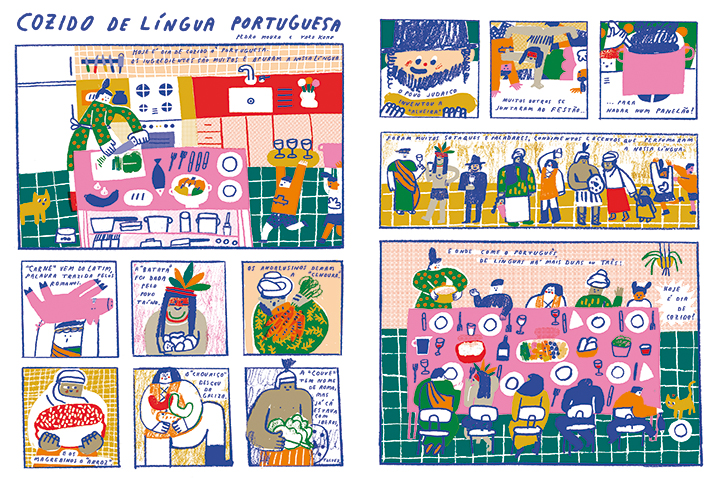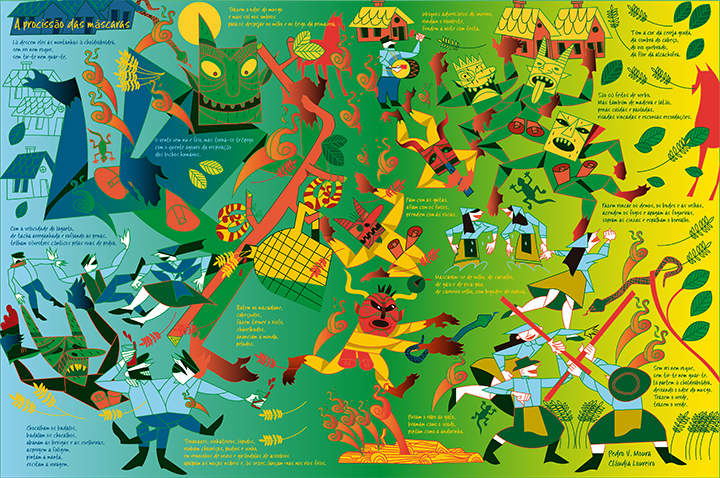




CO-POSITION
Composition, Coordination, and Communication in Comics in Collaboration – Experiences from Scriptwriter Pedro Moura and Artists
Ana Dias, André Catarino, André Pereira, Bernardo Majer, Carlos Páscoa, Carolina Moreira, Catarina Sobral, Ciço Silveira, Cláudia Loureiro, Daniel Maia, Daniel Silvestre da Silva, Diana David, Diogo Carvalho, Evandro Renan, Filipe Abranches, Hugo “Mao” Almeida, Joana Mosi, João Carola, João Catarino, Kachisou, Marta Teives, Martina Manyà, Miguel Rocha, Nuno Fragata, Pedro Franz, Quico Nogueira, Ricardo Paião de Oliveira, Rui Alex, Vasco Ruivo, Viktoriya Kurmayeva, Yara Kono
EXPOSIÇÃO
6 e 7 de Julho de 2023
Foyer do Centro Cultural e de Congressos das Caldas da Rainha
Apresentado no contexto da 10th International Conference on Illustration and Animation CONFIA 2023
Organização: Pedro Moura e ESAD.CR
Acknowledgements: a big thank you note to both the CONFIA organizers and ESAD for the trust put on this project, and the technical and human support in making it possible. Also, a big hug to all the artists present in this small show, but also those who have not been included but have been key in a long and yet ongoing learning process.
CO-POSITION
Composition, Coordination, and Communication in Comics in Collaboration – Experiences from Scriptwriter Pedro Moura and Artists
Comics in Collaboration
I have been writing for comics for a while. But as a non-artist, I always have to work with someone else, namely, someone who draws. But it is a wonderful experience to establish a relationship where two (or more) people cooperate to create something that would not be possible if done alone. I do not “write stories” (see below). I write comics, so dialog and mutual understanding with the artist is paramount. Sometimes “control” is stronger on some occasions, in the sense that I am a little more thorough with descriptions or instructions, but some other times the minimal text is enough, and the artist creates everything from their mind as titillated by the texts. In any case, the results are always surprising. I learn as much from collaborating with experienced veterans as with youngsters in their first gig. You will find many examples here of all kinds of collaboration.
Composition
There are many important stages and fundamental elements in comics-making. Figuration, visual style, panel transitions, sequentiality, genres, printing techniques, emanata, lettering qualities, and so on. Every little detail will contribute decisively to the holistic expression and semiotics of the comics piece. However, for me, a major element is composition – the arrangement of all and any of the visual elements across a single page, a spread or beyond, whether distributed through multiple clearcut panels or arranged as an overall singular image. You can also call it “mise en page,” page design, page layout, etc. Composition for me is what instills into a project its dynamics, its rhythm, its visual storytelling flavor. If I am given the opportunity to do it, I will think about composition from the get-go, sometimes it’s even what triggers or at least guides the writing. Of course, the artist is always free to change it a little, a lot or simply throw it away and rethink it. It’s all fine.
Coordination
It is paramount to know who you are collaborating with. Not in terms of their personal life (that’s another matter), but the dynamics of their visual proficiency. To know if an artist is a little more detailed in their linework or if they prefer a more abstract, expressive approach, if color is a forte or if theu’re obsessed with vanishing points may be crucial to find the right writing tone. A “scene” drawn in two radically different manners will NOT be the same scene. There is always a margin for surprises (more often than not positive, refreshing, enlightening), but it is also a good sign if you have an educated guess of where you’re both going when the writing meets the visuals.
Communication
There is no such thing as “mediumless” stories. These must have a tangible body, expressed, i.e., be out here in the outside. A story in one medium is not the “same” in another: they may share common traits but the journey is not the same. In comics, that means multiple images on a page (whatever the final support this may have, from paper to holograms) that are then put together through the reading act. Writing and drawing comics, or in other words, composing comics is to prepare a map that will provide a specific journey for the reader. These are fragments of an immense Atlas of comics-making, of meaning-weaving through the composition art of comics. Find the one best suited for you.
